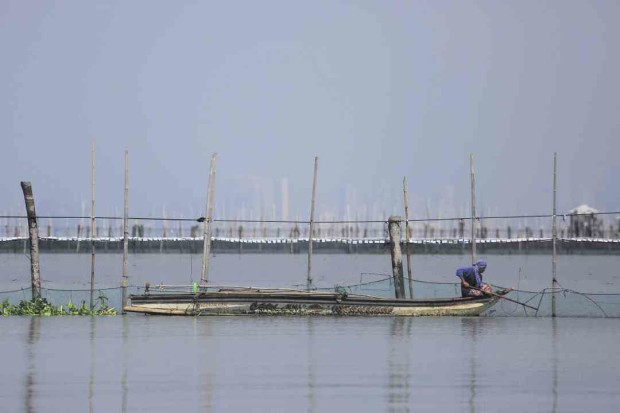
The government’s campaign to turn Laguna de Bay into an ecotourism zone will see the removal of commercial fish pens in the lake. —REM ZAMORA
SAN PEDRO CITY—Government agencies have stepped up efforts to clear the 90,000-hectare Laguna de Bay of aquaculture structures after the government-imposed deadline for fish pen operators to harvest their stocks lapsed last week.
On Tuesday, a team composed of personnel from the Department of Environment and Natural Resources (DENR), Laguna Lake Development Authority (LLDA), Philippine Navy, Philippine Coast Guard and Philippine National Police dismantled fish pens in the lake’s section in Binangonan and Cardona towns in Rizal province.
This happened as a group of fish pen operators went to Malacañang in an effort to temper the government’s clearing operations, the Inquirer learned from various sources.
But Environment Undersecretary Arturo Valdez, who heads the National Anti-Environmental Crime Task Force, said the government team on Tuesday started tearing down underwater fishnets, the fastest way to render the fish pens “inoperable.”
He said he was not aware of the operators’ meeting in Malacañang.
Mechanized equipment
“Ultimately, [we hope the lake is] cleared before the Sona (State of the Nation Address),” Valdez said.
It was in Mr. Duterte’s first Sona in July last year when he ordered the rehabilitation of Laguna de Bay by reducing fish pens and turning the lake into an ecotourism zone to benefit small fishermen and lakeside communities.
Of the entire lake area, about 12,000 ha are covered by fish pens owned by more or less 300 individuals and corporations.
The LLDA, in February, issued a one-year fishing moratorium as experts reviewed the lake’s natural carrying capacity for aquaculture.
Despite opposition from fish pen operators, the government set the March 31 ultimatum for them to harvest their stocks. The LLDA said operators who were delinquent in paying fees or whose structures went beyond the fishing zones were the first ones to go.
“Some may be thinking this is just some form of ningas cogon (but) we want to show them our determination,” Valdez said.
He, however, said uprooting the long and heavy bamboo poles that segregated the fish pens was “costly and tedious,” especially that the government had to do it manually.
Jaime Medina, LLDA general manager, earlier said that to dismantle a 50-ha pen, the government needed to spend about P500,000 for boat rentals and labor costs.
Valdez said this was why the DENR wanted to use mechanized equipment to hasten the demolition, a matter brought up by Environment Secretary Gina Lopez during Monday’s Cabinet meeting.
He said the costs were being discussed with the Department of Budget and Management.
“Once we have that [cutter], [demolition] will be faster.
In two months’ time, nothing will remain standing, everything [will be] shredded,” he said.